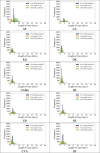A Real-Time Signal-Based Wavelet Long Short-Term Memory Method for Length-of-Stay Prediction for the Intensive Care Unit: Development and Evaluation Study
- PMID: 40835265
- PMCID: PMC12367335
- DOI: 10.2196/71247
A Real-Time Signal-Based Wavelet Long Short-Term Memory Method for Length-of-Stay Prediction for the Intensive Care Unit: Development and Evaluation Study
Abstract
Background: Efficient allocation of health care resources is essential for long-term hospital operation. Effective intensive care unit (ICU) management is essential for alleviating the financial strain on health care systems. Accurate prediction of length-of-stay in ICUs is vital for optimizing capacity planning and resource allocation, with the challenge of achieving early, real-time predictions.
Objective: This study aimed to develop a predictive model, namely wavelet long short-term memory model (WT-LSTM), for ICU length-of-stay using only real-time vital sign data. The model is designed for urgent care settings where demographic and historical patient data or laboratory results may be unavailable; the model leverages real-time inputs to deliver early and accurate ICU length-of-stay predictions.
Methods: The proposed model integrates discrete wavelet transformation and long short-term memory (LSTM) neural networks to filter noise from patients' vital sign series and improve length-of-stay prediction accuracy. Model performance was evaluated using the electronic ICU database, focusing on 10 common ICU admission diagnoses in the database.
Results: The results demonstrate that WT-LSTM consistently outperforms baseline models, including linear regression, LSTM, and bidirectional long short-term memory, in predicting ICU length-of-stay using vital sign data, achieving significant improvements in mean square error. Specifically, the wavelet transformation component of the model enhances the overall performance of WT-LSTM. Removing this component results in an average decrease of 3.3% in mean square error; such a phenomenon is particularly pronounced in specific patient cohorts. The model's adaptability is highlighted through real-time predictions using only 3-hour, 6-hour, 12-hour, and 24-hour input data. Using only 3 hours of input data, the WT-LSTM model delivers competitive results across the 10 most common ICU admission diagnoses, often outperforming Acute Physiology and Chronic Health Evaluation IV, the leading ICU outcome prediction system currently implemented in clinical practice. WT-LSTM effectively captures patterns from vital signs recorded during the initial hours of a patient's ICU stay, making it a promising tool for early prediction and resource optimization in the ICU.
Conclusions: Our proposed WT-LSTM model, based on real-time vital sign data, offers a promising solution for ICU length-of-stay prediction. Its high accuracy and early prediction capabilities hold significant potential for enhancing clinical practice, optimizing resource allocation, and supporting critical clinical and administrative decisions in ICU management.
Keywords: ICU management; convolutional layer; healthcare resource optimization; intensive care unit; real-time vital signs; signal processing; urgent care.
©Yiqun Jiang, Qing Li, Wenli Zhang. Originally published in JMIR AI (https://ai.jmir.org).
Conflict of interest statement
Figures




Similar articles
-
Prescription of Controlled Substances: Benefits and Risks.2025 Jul 6. In: StatPearls [Internet]. Treasure Island (FL): StatPearls Publishing; 2025 Jan–. 2025 Jul 6. In: StatPearls [Internet]. Treasure Island (FL): StatPearls Publishing; 2025 Jan–. PMID: 30726003 Free Books & Documents.
-
Are Current Survival Prediction Tools Useful When Treating Subsequent Skeletal-related Events From Bone Metastases?Clin Orthop Relat Res. 2024 Sep 1;482(9):1710-1721. doi: 10.1097/CORR.0000000000003030. Epub 2024 Mar 22. Clin Orthop Relat Res. 2024. PMID: 38517402 Free PMC article.
-
Predicting Episodes of Hypovigilance in Intensive Care Units Using Routine Physiological Parameters and Artificial Intelligence: Derivation Study.JMIR AI. 2025 Aug 27;4:e60885. doi: 10.2196/60885. JMIR AI. 2025. PMID: 40864885 Free PMC article.
-
Early warning systems and rapid response systems for the prevention of patient deterioration on acute adult hospital wards.Cochrane Database Syst Rev. 2021 Nov 22;11(11):CD005529. doi: 10.1002/14651858.CD005529.pub3. Cochrane Database Syst Rev. 2021. PMID: 34808700 Free PMC article.
-
Intravenous magnesium sulphate and sotalol for prevention of atrial fibrillation after coronary artery bypass surgery: a systematic review and economic evaluation.Health Technol Assess. 2008 Jun;12(28):iii-iv, ix-95. doi: 10.3310/hta12280. Health Technol Assess. 2008. PMID: 18547499
References
-
- Halpern NA, Bettes L, Greenstein R. Federal and nationwide intensive care units and healthcare costs: 1986-1992. Crit Care Med. 1994 Dec;22(12):2001–2007. Medline. - PubMed
-
- Azari A, Janeja VP, Mohseni A. Healthcare data mining: predicting hospital length of ltay (PHLOS) Int J Knowl Discov Bioinforma. 2012 Jul 1;3(3):44–66. doi: 10.4018/jkdb.2012070103. doi. - DOI
LinkOut - more resources
Full Text Sources

